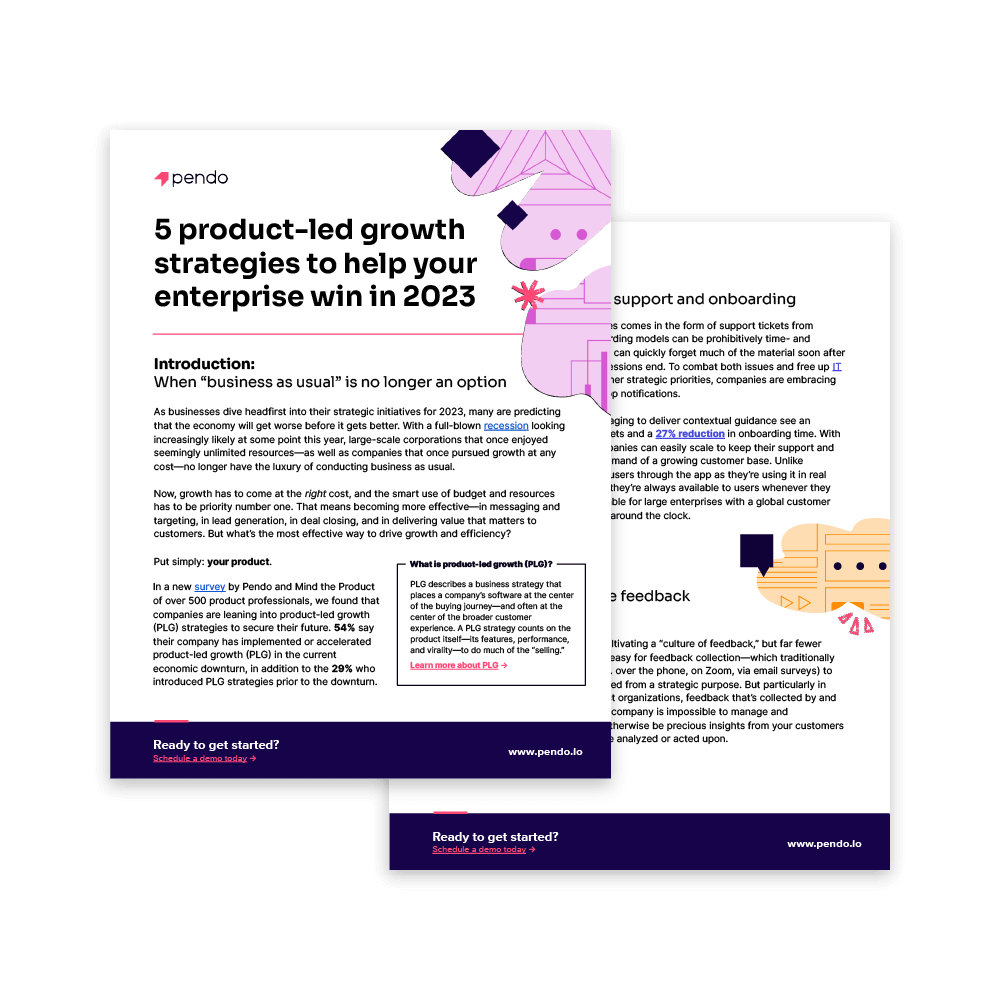Product Metrics That Drive Growth: A 2024 Guide

Product Metrics That Drive Growth: A 2024 Guide is an essential resource for businesses striving to achieve sustainable growth in today's highly competitive market.
By understanding and leveraging the key metrics that influence product success, companies can make data-driven decisions that lead to higher revenue, greater customer satisfaction, and increased market share.
This guide provides a comprehensive overview of the most significant product metrics and their impact on business outcomes.
Quick Summary
- Metrics should align with business goals: Choose metrics that directly impact your business objectives.
- Not all metrics are created equal: Focus on metrics that provide actionable insights and drive decision-making.
- Metrics should be specific: Avoid vague metrics and define them in a way that is measurable and meaningful.
- Metrics should be tracked consistently: Establish a regular cadence for tracking and analyzing metrics to identify trends and patterns.
- Metrics should be communicated effectively: Share metrics with stakeholders in a clear and concise manner to drive understanding and action.
Analogy To Help You Understand
Metrics are like ingredients in a recipe.
Just as a chef carefully selects the ingredients that will make their dish delicious, a product manager must carefully choose the metrics that will make their product successful. Just as a chef wouldn't add every ingredient in their pantry to a dish, a product manager shouldn't track every possible metric. Too many metrics can be overwhelming and make it difficult to focus on what really matters. Just as a chef tastes their dish throughout the cooking process to ensure it's turning out as expected, a product manager should regularly review their metrics to ensure they're on track to meet their goals. Just as a chef adjusts the seasoning to make their dish perfect, a product manager should adjust their metrics to ensure they're measuring the right things and getting the insights they need to make informed decisions. Ultimately, just as a delicious dish requires the right combination of ingredients, a successful product requires the right combination of metrics. Choose wisely and adjust as needed to create a winning recipe for your product.Introduction To Product Metrics

Welcome to the 2024 Guide on Product Metrics That Drive Growth!
This guide is for entrepreneurs, product managers, and those in charge of a company's products.
In this section, we'll discuss the Introduction to Product Metrics.
Why Product Metrics Matter
Product metrics are crucial for business growth as they provide insights into customer behavior and product performance.
Effective metrics offer measurable data that reflect specific user actions or outcomes.
To determine which metrics matter most to your business goals, start by understanding what you want to achieve with your products.
For instance, if increased revenue generation through sales activity improvements is the goal, then focusing on sales-related key-performance-indicators (KPIs) like conversion rate can give valuable insight into potential areas needing development.
5 Reasons Why
Introduction To Product Metrics
- Good metric selection leads directly towards informed decision-making
- A solid grasp of available KPIs allows meaningful comparisons between different project/program parts
- Properly chosen metrics help identify strengths & weaknesses within a given process/product/service.
- Understanding how each metric relates back up-stream/downstream helps optimize entire systems
- Clear communication around selected KPIs ensures everyone understands their role in achieving success
Metrics are like a compass that guides you towards your business goals.
Without them, you're lost.
By understanding the importance of product metrics and selecting the right ones, you can make informed decisions, identify areas for improvement, and optimize your entire system for success.
Some Interesting Opinions
1. User engagement metrics are overrated.
Studies show that there is no correlation between user engagement and revenue growth. Instead, focus on metrics that directly impact your bottom line, such as customer acquisition cost and lifetime value.2. Net Promoter Score (NPS) is a flawed metric.
Research has found that NPS is not a reliable predictor of customer loyalty or business growth. Instead, use metrics like customer retention rate and referral rate to measure customer satisfaction and advocacy.3. Churn rate is not always a bad thing.
While high churn rates can be a sign of a problem, they can also indicate that your product is not a good fit for certain customers. It's better to focus on retaining the right customers rather than trying to keep everyone.4. Vanity metrics are a waste of time.
Metrics like social media followers and website traffic may look impressive, but they don't necessarily translate into business success. Instead, focus on metrics that directly impact your business goals, such as conversion rate and revenue.5. Customer satisfaction is not the ultimate goal.
While it's important to make customers happy, it's not the only goal of a business. Ultimately, the goal is to create value for customers and generate revenue. Don't sacrifice long-term profitability for short-term customer satisfaction.The Role Of Product Metrics In Driving Growth

Why Product Metrics are Essential for Business Success
Product metrics are crucial for driving growth and identifying areas for improvement.
By measuring user engagement through customer acquisition cost (CAC) and lifetime value (LTV), companies can determine whether users find their products valuable enough to continue using after initial adoption.
This paves the way for repeat purchases and loyalty.
Metrics also help organizations understand what works best when launching products or features.
By monitoring usage patterns over time, teams can gather detailed insights and create better products aligned with user needs.
Product Metrics indicate market demand today while providing insights into possible future opportunities by reflecting shortcomings within existing offerings while indicating gaps between desired outcomes/expectations versus actual results achieved.
How to Use Product Metrics to Improve Your Business
Here are some tips for using product metrics to drive business success
- Monitor feedback from users to identify areas for improvement
- Track key performance indicators (KPIs) such as ROI and LTV to measure product success
- Use focus groups to gain a better understanding of customers' needs and preferences
By using product metrics to inform strategic decisions, companies can create better products and drive business success.
Defining Key Performance Indicators (KPIs)
Why Defining KPIs is Crucial for Business Growth
Defining KPIs is crucial for business growth.
KPIs measure values to track and evaluate performance objectives, identify areas needing improvement, and provide real-time feedback on progress towards targets.
Aligning KPIs with Strategic Goals
Aligning KPIs with strategic goals ensures success by knowing which metrics drive growth toward desired outcomes.
Analyze key drivers impacting long-term goals before deciding what to track regularly.
Developing Meaningful KPIs
Develop meaningful KPIs by identifying specific SMART (Specific, Measurable, Achievable, Relevant, & Time-bound) targets based on current data trends or industry standards.
Set up regular check-ins with team members responsible for tracking these numbers.
“Clearly defined KPIs hold fantastic value because they keep all departments focused, provide accountability, assist in decision-making processes through accurate insights into company performance levels while also helping businesses stay competitive within their respective industries.”
Clearly defined KPIs hold fantastic value because they keep all departments focused, provide accountability, and assist in decision-making processes through accurate insights into company performance levels.
They also help businesses stay competitive within their respective industries.
Conclusion
Defining KPIs is crucial for business growth.
Aligning KPIs with strategic goals and developing meaningful KPIs are essential steps to ensure success.
Clearly defined KPIs hold fantastic value and help businesses stay competitive within their respective industries.
My Experience: The Real Problems
1. Vanity metrics are a waste of time and resources.
Stop focusing on metrics that make you feel good but don't actually impact your bottom line. Only track metrics that directly contribute to revenue or customer satisfaction. According to a study by Mixpanel, only 12% of companies surveyed said they were "very effective" at using data to improve their business.2. Customer retention is more important than customer acquisition.
Stop obsessing over new customers and start focusing on keeping the ones you have. It costs 5-25 times more to acquire a new customer than to retain an existing one. A study by Bain & Company found that increasing customer retention rates by just 5% can increase profits by 25-95%.3. Net Promoter Score (NPS) is a flawed metric.
Stop relying on NPS as the be-all and end-all of customer satisfaction metrics. It's a simplistic measure that doesn't take into account the complexity of customer experience. A study by CustomerGauge found that only 30% of customers who gave a company a high NPS score actually stayed loyal to that company.4. A/B testing is overrated.
Stop relying on A/B testing to make decisions. It's a flawed methodology that doesn't take into account the complexity of human behavior. A study by ConversionXL found that only 1 out of 8 A/B tests actually resulted in a statistically significant improvement.5. The real problem is not finding the right metrics, it's using them effectively.
Stop blaming your lack of success on not having the right metrics. The real problem is not knowing how to use the metrics you have to make informed decisions. A study by McKinsey & Company found that only 8% of companies surveyed said they had a "fully functional" data-driven culture.Measuring User Engagement And Retention

Why Measuring User Engagement and Retention is Crucial for Your Product Strategy
Measuring user engagement and retention is crucial for a successful product strategy
It identifies how actively users engage with your product and if they remain loyal over time.
Metrics like:
- Time spent
- Frequency of use
- Features used per session
help measure engagement.
“Engagement is not just about spending time with your product, it's about investing time in it.”
Net Promoter Score (NPS) is particularly useful in measuring user engagement as it determines the likelihood of recommending your product to others.
Tracking NPS against industry benchmarks helps determine perceived value.
“NPS is not just a metric, it's a mindset.It's a way of doing business that puts the customer first.”
Understanding why people leave or stop using services through exit surveys provides feedback to improve customer experience leading to increased revenue growth by targeting areas that need improvement.
“Customer feedback is the breakfast of champions.”
By understanding both aspects - engagement and churn - businesses can work on improving long-term efficiency rather than short term benefits keeping audiences engaged.
“Engagement is the key to long-term success.Churn is the enemy of growth.”
Analyzing Customer Acquisition Cost (CAC)

Why Customer Acquisition Cost (CAC) Analysis is Crucial for Product-Based Businesses
Customer Acquisition Cost (CAC) analysis is crucial for product-based businesses.
CAC represents the cost of acquiring each new customer and determines marketing strategy efficiency.
To calculate CAC, divide total marketing expenses by the number of new customers acquired within a specific period.
How Analyzing CAC Helps Your Business
Analyzing CAC helps identify channels that bring in more leads and conversions than others.
This data enables focusing on high-performing campaigns while cutting off low-return ones to drive growth effectively.
Monitoring changes in CAC over time provides insight into future investment needs for acquiring customers.
Understanding your business's CAC streamlines marketing efforts and invests resources efficiently into sustainable growth strategies.
Five Key Takeaways for Your Business
- Monitor changes in customer acquisition cost to stay on top of your marketing expenses.
- Identify successful versus struggling campaigns to focus on high-performing campaigns.
- Focus on effective channels with higher returns to drive growth effectively.
- Match costs against revenue generated from acquisitions to evaluate profitability.
- Calculate lifetime value (LTV) when evaluating profitability to ensure sustainable growth.
My Personal Insights
When I first started AtOnce, I was obsessed with tracking every metric possible. I wanted to know how many users we had, how long they spent on the platform, and how many messages they sent. I thought that by tracking everything, I would be able to make informed decisions about the product. But as time went on, I realized that not all metrics are created equal. Some metrics are vanity metrics that make you feel good but don't actually tell you anything useful. Other metrics are key performance indicators (KPIs) that give you valuable insights into how your product is performing. One KPI that we found to be incredibly important for AtOnce was our response time. We realized that our users were using our platform to communicate with their customers in real-time, so it was crucial that we responded to their messages quickly. We set a goal of responding to all messages within 30 seconds, and we tracked our progress towards that goal every day. By focusing on our response time, we were able to make significant improvements to our product. We optimized our algorithms to prioritize incoming messages based on urgency, and we added features like canned responses to help our users respond more quickly. As a result, our users were able to provide better customer service, which led to higher customer satisfaction and retention rates. Our experience with AtOnce taught us that finding the right metrics to track is crucial for the success of any product. By focusing on the metrics that matter, we were able to make data-driven decisions that led to real improvements in our product and our business.Understanding User Conversion Funnel

Understanding the User Conversion Funnel
Driving product growth requires a deep understanding of the user conversion funnel
This funnel consists of several stages, from awareness to retention, and each stage can help identify areas where users might fall out before becoming paying customers.
Track Every Touchpoint
To understand the funnel, track every touchpoint a customer makes with your product.
This includes website visits,social media engagement, email sign-ups, and more.
These interactions define key metrics such as CPA, LTSR, and LTV.
With this information at hand, businesses can better understand which channels drive valuable traffic into their online properties.
Optimize Channels and Identify Pain Points
Optimize channels where users drop off frequently by identifying pain points within steps of the funnel.
For example, if many potential buyers abandon cart processes on the payment page, user surveys could give insights on what caused frustration during the checkout process leading them away from purchasing something successfully.
Rectifying these issues will improve user experience across all platforms and drive further success down the line for company efforts towards improving UX.
“Understanding the user conversion funnel is crucial for driving product growth.”
“Optimizing channels and identifying pain points can help improve user experience and drive success.”
“Tracking every touchpoint is essential to understanding which channels drive valuable traffic.”
Tracking Churn Rate

Why Measuring Churn Rate is Crucial for Product Growth
Churn rate is the percentage of customers who stop using your product over a given period, calculated monthly or annually.
It helps identify underlying issues with your product that users may dislike or find challenging.
Regular tracking enables swift adjustments before things worsen.
How to Calculate Churn Rate
To calculate overall churn rate, divide the number of discontinued users by the total active users during that time frame multiplied by 100%.
Segmenting data based on new vs existing customers provides more insights into areas needing improvement.
Ways to Reduce Churn Rate
- Track usage frequency
- Analyze negative feedback channels
- Use chatbots as support tools
- Send personalized messages after inactivity periods
- Improve user engagement features
Tracking churn rates unlocks opportunities to create better products and retain loyal customers over time.
Calculating Lifetime Value (LTV) Of Customers

Calculating Lifetime Value (LTV)
Understanding the value of each customer over time is crucial for businesses.
To do this, calculating Lifetime Value (LTV) is essential.
To calculate LTV, consider the following factors:
- Average purchase amount
- Frequency of purchases
- Retention rate
This determines how much revenue a single customer generates in their lifetime.
Churn Rate
Churn rate is an important component when calculating LTV. It refers to the percentage of customers who stop using or purchasing from your product within a given period.
High churn rates negatively impact bottom lines since acquiring new customers costs more than retaining old ones.
Increasing LTVs and Decreasing Churn Rates
To increase LTVs and decrease churn rates, provide exceptional experiences throughout their journey with your brand.
Implement loyalty programs that:
- Reward frequent purchasers
- Offer incentives for referrals
This may encourage them to become loyal advocates for your brand.
Remember, it's more cost-effective to retain customers than to acquire new ones.
By focusing on LTV and churn rate, you can improve your bottom line and build a loyal customer base that will continue to generate revenue for your business.
Optimize Pricing With Profitability Analysis

Optimizing Pricing Strategy for Growth
To drive growth for your product, optimizing pricing strategy is crucial.
Finding the sweet spot where customer needs are met and profit margins maximized can be challenging.
Profitability analysis provides detailed insights into different aspects of your business to achieve this balance.
“Evaluate which products generate higher profits and make data-driven decisions about pricing adjustments.”
Conducting profitability analysis also reveals valuable information on customer behavior patterns such as willingness to pay at each price point and spending habits with/without discounts.
Use this insight when creating targeted marketing campaigns that align with sales goals.
“Optimizing product pricing should be a continuous process due to many variables involved in determining success.”
Steps to Optimize Pricing Strategy
Follow these steps:
- Analyze sales numbers & costs associated with production or fulfillment
- Gather consumer feedback on factors influencing purchase decision including brand recognition / loyalty
- Create clear pricing strategies for various market segments
- Periodically re-evaluate prices based on performance metrics
- Continuously monitor competitor's prices
Optimizing product pricing should be a continuous process due to many variables involved in determining success.
By following these steps, you can ensure that your pricing strategy is always aligned with your business goals and customer needs.
Final Takeaways
As a founder, I know how important it is to track the right metrics for your product. It can be overwhelming to sift through all the data and figure out what really matters. But trust me, it's worth it. When I started AtOnce, I knew that our success would depend on our ability to provide value to our customers. That's why we use a combination of quantitative and qualitative metrics to measure our impact. On the quantitative side, we track things like user engagement, conversion rates, and revenue. These metrics give us a high-level view of how our product is performing and help us identify areas for improvement. But we also know that numbers only tell part of the story. That's why we use qualitative metrics like customer feedback and user surveys to get a deeper understanding of how our product is being used and how we can make it better. AtOnce is an AI-powered writing and customer service tool that helps businesses communicate more effectively with their customers. We use natural language processing and machine learning to analyze customer inquiries and provide personalized responses in real-time. One of the ways we measure our impact is by tracking the number of customer inquiries that are resolved on the first interaction. This metric tells us how well our AI is performing and how satisfied our customers are with the service. Another important metric for us is customer retention. We want to make sure that our customers are not only satisfied with our product but also see the value in continuing to use it over time. Ultimately, finding the metrics that matter for your product is about understanding what success looks like for your business and your customers. By tracking the right metrics, you can make data-driven decisions that will help you grow and improve your product over time.Are you struggling to create marketing content that converts?
- Do you spend hours staring at a blank screen?
- Are you tired of working with unreliable freelancers?
- Is your writing style inconsistent and hard to read?
- Do you want to save time and money on content creation?
Introducing AtOnce - your AI writing assistant
With AtOnce, you can create high-quality content in minutes:
- Get custom writing prompts based on your goals and audience
- Automatically generate engaging headlines and intros
- Write clear, concise copy with our in-editor guidance
- Revise and optimize your copy for SEO and readability
- Collaborate with team members in real-time
Experience the power of AI-driven writing
AtOnce uses artificial intelligence to understand your unique writing style and preferences:
- Our software analyzes your writing and provides personalized suggestions
- We learn from your feedback and improve over time
- Get instant access to a wealth of writing resources, including templates, examples, and best practices
- Easily integrate AtOnce with your favorite writing tools, like Google Docs and WordPress
- Save time and focus on what you do best - growing your business
Your writing revolution starts now
Join the thousands of businesses already using AtOnce to supercharge their writing:
- Eliminate writer's block and create content that resonates with your audience
- Fuel your marketing campaigns with powerful copy that converts
- Build your brand and establish your authority online
- Streamline your content creation process and save money in the long run
Get started with AtOnce today
Sign up for our free trial and experience the benefits of AI writing for yourself:
- No credit card required
- Cancel anytime
- Unleash your writing potential with AtOnce
What are the key product metrics that drive growth in 2023?
The key product metrics that drive growth in 2023 are user acquisition, retention, engagement, and monetization.
How can user acquisition be improved to drive growth in 2023?
User acquisition can be improved in 2023 by leveraging social media, influencer marketing, and search engine optimization (SEO) to increase brand awareness and attract new users.
What strategies can be used to improve user retention and engagement in 2023?
Strategies that can be used to improve user retention and engagement in 2023 include personalization, gamification, push notifications, and in-app messaging.
